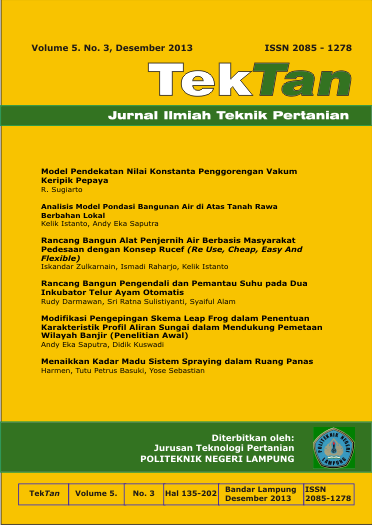Rancang Bangun Alat Penjernih Air Berbasis Masyarakat Pedesaan dengan Konsep Rucef (Re Use, Cheap, Easy And Flexible)
DOI:
https://doi.org/10.25181/tektan.v5i3.850Abstrak
These the water purification tools are designed based on household needs that carrying the concept RUCEP (Re Use, Cheap, Easy and Flexible). The purpose of this research were: 1). Designing a simple water purification technology which is inexpensive, and easy to applied for rural communities in terms of producing clean water; 2). Determining the values changes of physical parameter which includes the TDS values, turbidity values and pH value, 3). Determining the value changes of bacteriological parameter such as content of Ecoli bacteria in water and total number of colieform. Based on the research, an average outlet discharge that produces water with clean visual quality is 1.964 liters/hour with a contact time of 1 hour 8 minutes. The measurement of TDS parameters showed that results for 6 hours, average of the TDS value is 154.33 ppm which is increased on average 17.81% from the initial TDS value 131 ppm. The result of turbidity measurements showed that for 6 hours, average turbidity value is 8.388 NTU which is improved on average 87.60% from the initial turbidity value about 67.67 NTU. The measurement of pH paramater showed the results that for 6 hours, average of pH is 7.85 which decreased from the initial pH of the raw water at 8.24. While the average temperature of the water from filtration is still relatively the same as the raw water is 27.18oC. The measurement of the   E-Colie bacteria contents in samples of raw water and water filtration showed negative results for E-Colie bacteria contents, but the total of coliforms decreased from 14 mpn to 9.2 mpn or decreased about 34.286%. Keywords: technology, water purification, rural clean waterUnduhan
Referensi
Akhirudin, H.N., Suharjo. 2007., “Pengaruh Massa dan Ukuran Biji Kelor pada Proses Penjernihan Airâ€., Jurnal Penelitian Sains & Teknologi, Vol. 8, No. 2, 2007: 144 - 154
Anonim, 2010. “Progresif Book - Membuat Alat Penjernih Air Bebas Penyakit., Yogyakarta., http://soebrontokollek.blogspot.com.
Droste, Ronald L., 1997., “Theory and Practice of Water and Wastewater Treatmentâ€., John Willey and Sons Inc., USA.
Kusnaedi., 2010., “Mengolah Air Kotor untuk Air Minumâ€., Jakarta., Penebar Swadaya.
Mifbakhuddin., 2010., “Pengaruh Ketebalan Karbon Aktif Sebagai Media Filter Terhadap Penurunan Kesadahan Air Sumur Artetisâ€., Jurnal Eksplanasi Volume 5 Nomor 2 Edisi Oktober 2010.
Pandia.S., Husin. A., 2007. “ Pengaruh Massa dan Ukuran Biji Kelor pada Proses Penjernihan Air†Jurnal Teknologi Proses 4(2) Juli 2005 : 26 – 33.
Ristiana, N., Astuti, D., Kurniawan, P.T., 2009. “Keefektifan Ketebalan Kombinasi Zeolit Dengan Arang Aktif Dalam Menurunkan Kadar Kesadahan Air Sumur Di Karang Tengah Weru Kabupaten Sukoharjo†Jurnal Kesehatan, ISSN 1979-7621, VOL. 2, NO. 1, JUNI 2009 Hal 91-102
Saparuddin. 2010. “Pemanfaatan Air Tanah Dangkal Sebagai Sumber Air Bersih Di Kampus Bumi Bahari Palu†Jurnal SMARTek, Vol. 8, No. 2, Mei 2010: 143 - 152



